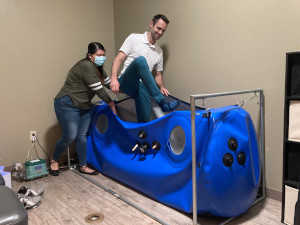
Chiropractor Chandler AZ
Hyperbaric Oxygen Therapy for Fibromyalgia Syndrome
Fibromyalgia syndrome is a musculoskeletal disorder characterized by widespread bilateral pain as well as specific tender points. Comorbidities include fatigue, anxiety, depression, short and long-term memory impairment, sleep disturbance and irritable bowel syndrome (Yildiz et al., 2004). Initial diagnosis criteria from the American College of Rheumatology involved assessment of the tender points, but more recent criteria focus on the widespread constant pain and other symptoms described above (Efarati et al., 2015).
 The condition affects about nine times as many women as men (Efrati et al., 2015), with prevalence estimated at 2-4% of the population. Triggers can include physical and/or psychological trauma, viral illness, Lyme disease, muscle overload, poor spinal posture, sleep disturbance and reduced availability of high-energy phosphate (ATP) to fuel the muscles (Yildiz et al., 2004; Efrati et al., 2015)). There is no known cure for fibromyalgia, and current therapeutic approaches (pharmacotherapy, exercise, cognitive behavioral therapy) focus primarily on symptom management (Efrati et al., 2015).
The condition affects about nine times as many women as men (Efrati et al., 2015), with prevalence estimated at 2-4% of the population. Triggers can include physical and/or psychological trauma, viral illness, Lyme disease, muscle overload, poor spinal posture, sleep disturbance and reduced availability of high-energy phosphate (ATP) to fuel the muscles (Yildiz et al., 2004; Efrati et al., 2015)). There is no known cure for fibromyalgia, and current therapeutic approaches (pharmacotherapy, exercise, cognitive behavioral therapy) focus primarily on symptom management (Efrati et al., 2015).
Two clinical trials using a case-control crossover design have yielded optimistic results for using hyperbaric oxygen therapy for treated fibromyalgia. A case control design utilizes two groups of patients, both of whom receive treatment and then act as their own controls or comparison group during an equal period of no treatment. Each study involved populations of male and female patients with clinically diagnosed fibromyalgia. In both cases, patients reported statistically significant improvements in symptom reduction following the hyperbaric oxygen treatments.
What is hyperbaric oxygen therapy and how does it work?

Hyperbaric oxygen therapy involves administering pure oxygen to patients inside of a chamber pressurized above sea level atmospheric pressure (1 ATA). Hyperbaric chambers are of two designs: large multiplace chambers that hold up to eight patients and an overseer, generally found in tertiary care facilities such as hospitals, and single monoplace chambers that hold a single patient (Schaefer, 1992). Chambers are pressurized to between 1.3 and 3.0 ATA, with sessions lasting up to two hours. Patients typically undergo multiple treatments in order to receive the most benefit.
Oxygen is essential to human life. Without it cells, particularly those in the brain, die quickly. The purpose of our circulatory system is to deliver oxygen to vital tissues and organs and cycle carbon dioxide back to the lungs to be expelled. Oxygen is carried in the blood in two ways: most of it is attached to hemoglobin (inside red blood cells), while a much smaller percentage is dissolved within the blood plasma.
Oxygen content in the air we breathe is about 20%. By delivering pure oxygen at high atmospheric pressures, it is possible to increase the amount of oxygen dissolved in blood plasma while the hemoglobin content remains the same (Tibbles & Edelsberg, 1996). In other words, the blood becomes super-oxygenated, giving damaged tissues more of what they need to generate new, healthy cells. Unlike many chemicals in the body, oxygen can easily cross the blood-brain barrier (BBB), making hyperbaric oxygen therapy effective for neurological disorders affecting the central nervous system as well as those in the periphery.
How does hyperbaric oxygen therapy work to treat fibromyalgia?
Although researchers have documented its efficacy, all of the mechanisms by which hyperbaric oxygen therapy improves fibromyalgia symptoms remain unclear. A popular theory is that the hyperbaric oxygen therapy works to reverse local hypoxia (Yildiz et al., 2004) or oxygen starvation that occurs both within the brain and peripheral soft tissue. Hypoxia can be a trigger for affective disorders such as anxiety and depression, and it also impacts metabolism of energy within the muscles, since aerobic metabolism produces more usable energy than anaerobic metabolism. There is also evidence that hyperbaric oxygen therapy can promote the development of new capillary networks around damaged tissue, in order to make oxygen delivery to these areas more efficient (Yildiz et al., 2004).
Hyperbaric oxygen therapy protocol
A typical treatment lasts 90 minutes: 15 minutes on either end to pressurize and depressurize the chamber, and 60 minutes of actual treatment time. Similar to being on airplanes during take-off and landing, patients may feel pressure inside the ears during pressurization and depressurization, which is usually resolved by clearing the ears. Let the provider know if allergies or a current sinus infection could make this more severe. The machine makes some noise, but most individuals feel comfortable reading or relaxing during treatment. An intercom enables the patient to communicate with the provider. Those individuals who are uncomfortable in enclosed spaces (claustrophobia) should let their provider know, so they can be instructed as to relaxation techniques during treatment.
References
Efrati, S. et al. (2015). Hyperbaric oxygen therapy can diminish fibromyalgia syndrome- Prospective clinical trial. PLOS One, 10(5), e0127012. https://www.doi.org/10.1371/journal.pone.0127012
Schaefer, S. (1992). Fundamentals of hyperbaric oxygen therapy. Orthopaedic Nursing, 11(6), 9-15.
Tibbles, P. & Edelsberg, J. (1996). Hyperbaric oxygen therapy. New England Journal of Medicine, 334(5), 1642-1648.
Yildiz, S. et al. (2004). A new treatment modality for fibromyalgia syndrome: hyperbaric oxygen therapy. The Journal of International Medical Research, 32, 263-267.